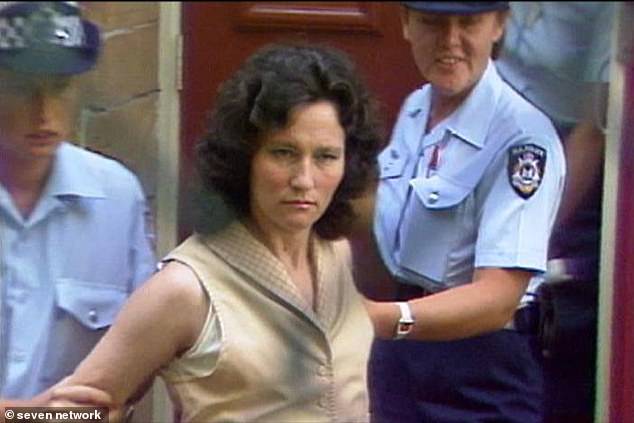Australia’s criminal history is stained with the names of women whose actions still disturb and fascinate.
From Catherine Birnie’s calculated reign of terror – abducting, raping and murdering four young women alongside her husband – to the chilling cruelty of the teenage ‘Collie Killers’, who strangled their friend simply because it ‘felt right’. And who could forget Katherine Knight’s use of her abattoir butchering skills to kill her partner in a murder so grotesque and cruel it still defies belief.
These cases stand among the most chilling chapters in Australia’s criminal history.
For years, these women have been cast as monsters, yet beneath the headlines and horror stories, not every female accused of murder is what she seems.
In my years of research as a journalist and through the countless interviews I’ve carried out as a true crime author, I’ve uncovered inconsistencies and challenged the narratives we have been fed by the courts and media.
Among the hall of infamy there is one case – one woman – who I believe is innocent. A woman branded a killer, yet her story doesn’t fit the mould.
Misunderstood? Wrongfully convicted? Or a casualty of a justice system quick to condemn?
Firstly, let’s take another look at some of Australia’s worst female killers – then we’ll take an exclusive deep dive into the case of one convicted murderer whose handwritten letters from prison tell a different story…

Catherine Birnie played an active role in seeking victims for her and her husband David to kill. She would use the phrase ‘I’ve got the munchies’ to signal when she had found a target
Catherine Birnie
In 1986, Catherine Birnie and her husband David unleashed a reign of terror in Perth, abducting, raping and murdering four women.
Far from a bystander, Catherine played an active role in selecting victims. She would scan the streets for young women, using the phrase ‘I’ve got the munchies’ to signal David when she had found a target.
Once inside their car, her presence offered a deceptive sense of security; few would suspect a woman of being an accomplice to abduction and murder.
But that illusion of safety masked the horrors that awaited at their home on Moorhouse Street, Willagee.
Their first victim, 22-year-old Mary Frances Neilson, was lured under the pretense of buying cheap tyres. She was bound, assaulted and murdered.
Susannah Candy, 15, was kidnapped then strangled. Noelene Patterson, 31, endured days of captivity and repeated assaults before Catherine pressured David to kill her. Denise Brown, 21, was stabbed to death in a remote forest.
The killing spree ended when a fifth intended victim escaped and alerted police. David Birnie took his own life in prison in 2005.
Catherine, completely devoid of remorse, remains incarcerated – a living reminder of how depravity can lurk among the ordinary.
The Collie Murderers

Eliza Davis was murdered by two 16-year-old girls, who to this day still cannot be legally named
In June 2006, the small WA town of Collie became the setting for a murder that remains baffling to this day, committed without a clear motive and leaving more questions than answers.
Two 16-year-old girls, whose identities remain protected, murdered their friend, 15-year-old Eliza Jane Davis, in a sickening premeditated attack.
After a night of partying, the teenagers woke up and decided to kill Eliza, strangling her with wire while pressing a chemical-soaked cloth over her face.
Later, they buried her body in a shallow grave under a house and reported her missing, even assisting in search efforts before eventually turning themselves in.
One of the girls told police, ‘Sunday morning, me and her woke up and we were just talking, and for some reason we just decided to kill her.’
In police interviews, the girls admitted they had previously discussed killing someone, claiming they wanted a method that was ‘quick’ and ‘non-messy’. One girl had even practised by killing two kittens.
Both were sentenced to life in prison, with a minimum of 15 years. They were eligible for parole in 2022; however, due to laws protecting their identities, it is unknown whether they have been released.
Despite extensive psychological assessments, no clear motive was ever uncovered. Even in court, one of the girls could only offer a chilling response: ‘We knew it was wrong, but it didn’t feel wrong at all; it just felt right.’
Katherine Knight
In 2000, the quiet town of Aberdeen, NSW, became the setting for a crime so brutal that, even 25 years later, it defies belief.
The then-44-year-old Katherine Knight, an abattoir worker and mother of four, had been in an on-again, off-again relationship with John Price.
On the night of February 29, after an argument, Knight attacked Price in his sleep, stabbing him at least 37 times with a butcher’s knife. But this was no ordinary murder; it was one of the most grotesque and depraved killings Australia had ever seen.

Katherine Knight’s crime was so brutal that it defies belief, even 25 years later

Katherine Knight had been in an on-off relationship with John Price (pictured) before attacking him in his sleep
In a display of unimaginable savagery, drawing on the butchering skills she’d honed over years in the abattoir, she skinned his body with disturbing precision, hung his skin from a meat hook, and attempted to cook parts of his flesh, serving them with vegetables as a twisted ‘meal’ for his children.
Knight was arrested the next day, showing no real remorse. She pleaded guilty and was sentenced to life without the possibility of release.
Her crime was an act of brutality so extreme that even veteran investigators struggled to grasp the full horror of what had unfolded.
Keli Lane
But there’s one case that still doesn’t sit right with me: the conviction of Keli Lane.
Unlike most murder cases, there was no body, no forensic evidence and no motive that made sense.
Keli was found guilty of killing her newborn daughter, Tegan, based largely on circumstantial evidence and the fact she had concealed multiple pregnancies.
The prosecution built its case on inconsistencies in her story and painted her as a self-absorbed athlete who saw motherhood as an inconvenience.
But after years of investigating this case, speaking with those who knew her, and even visiting Keli multiple times in prison, I believe she is innocent.

I’ve visited Keli Lane in prison and received letters from her, and I believe she is innocent
Keli secretly gave birth to three children. She legally placed the first and third for adoption, but the second child, Tegan, disappeared without a trace.
Her friends and family had no idea she was pregnant. The fact she concealed her pregnancies and births, not just from her on-off partner at the time, but from those closest to her, adds an almost surreal element to the story.
Keli’s version of events changed multiple times, but the version she eventually stood by – that she had given Tegan to the baby’s biological father (named Andrew Morris or Norris), with whom she’d had an affair – became her downfall.
As someone close to the case once told me, ‘If she’d said that she only knew him as Andrew and not given police a name to disprove, then she might not be in prison.’
It was 1996 when then-21-year-old Keli gave birth to Tegan at Auburn Hospital. Shortly after being discharged with her baby, she attended a friend’s wedding.
It wasn’t until years later, when she arranged the adoption of her third child, that questions arose about what had happened to Tegan.
Keli has always maintained her innocence. She claims she handed Tegan over to the child’s biological father, a man named either Andrew Morris or Norris.
The search for this man led to one of the biggest manhunts in Australian history, but he has never been found.

I asked Keli directly if she killed her baby. She looked me right in the eye as she responded
In 2010, Keli was found guilty by a NSW Supreme Court jury of murdering Tegan. She was sentenced to a maximum of 18 years behind bars, with a non-parole period of 13 years and five months.
Like most people, I found Keli’s case fascinating. It’s highly unusual for a woman to be convicted of murder. And this case in particular is fascinating because there is no evidence Tegan is dead.
I started researching her story for my true crime book Fatal Females, which unexpectedly brought even more information my way. In 2016, I began visiting Keli in prison alongside her then-fiancé.
As prison visitors are not allowed to bring anything with them – this includes pen and paper – there is only so much you can memorise in a lengthy conversion.
So I asked Keli if I could write a letter with a list of questions I believed people would like answers for. This led to her writing to me two times, with lengthy answers she wished she’d been able to give in court.
The first time I met Keli I was so surprised. The Crown had painted her as being a ‘cold, calculating ice queen’. Instead she was vibrant, bubbly, very articulate and very passionate about her innocence.
When I asked her, ‘Keli, did you kill your baby?’ she looked me in the eyes and said, ‘I did not kill my baby! Why on Earth would I go to the trouble of having her details on a Medicare card if I planned on killing her the next day?’
Following that meeting, I wrote my first letter, asking her to elaborate on the topic of the Medicare card.
This is what Keli said:
I have always had the baby registered on my Medicare card. The evidence given by the Medicare office is I had the paperwork within 48 hours of her birth and a card was issued to me immediately. Why, if I’m trying to cover a murder, would I put her on my Medicare card for all to see? If I’d gone that far by hiding the pregnancy from my family, why would I link myself to a government agency and paperwork if I’d just killed her? It doesn’t make any sense and the Judge really struggled with this point.
Here are some other crucial insights from Keli from the Q&A in our letters.
I asked Keli: Why do you believe the time frame of you leaving the hospital to appearing at your friend’s wedding was manipulated?
Keli responded: There isn’t ANY police investigation from the time I left the hospital to the time I arrived home in Fairlight. The police never searched for CCTV footage, never trialled the drive themselves, talked to my neighbours, or asked taxi companies. There is no evidence at all for that time and therefore the Crown just speculated and made it up.
I originally told police I left hospital ‘about lunchtime’ (this was seven years later and during a stressful police interview) The medical records, which I did not have any access to or any knowledge of before the trial, says I was discharged at 2pm. I was home by 3pm which was confirmed by Mum to police, before I had even talked to her about the police investigation. I was filmed at a wedding at 4pm. The police never investigated this period of time, nor did they drive the route to see how long it took (it takes approx. one hour).
The police never questioned the timeline until they ‘needed’ extra time to give me the ‘opportunity’ to kill and dispose of my baby. If they went off the actual facts, it wouldn’t sound as good to the jury if I didn’t have ‘enough time’. In all fact, I didn’t! Even if I left a little earlier than 2pm, I still didn’t have the ‘opportunity’ as I didn’t have a car at the hospital.
I had to get myself home, by taxi, after Andrew decided not to drop me home. Once I got to my house, I got a few things together and got my car, then I drove to Fairlight by 3pm. Suddenly, because the facts matched my account, the police/Crown witnesses started to alter their evidence around ‘time!’
Not one person came forward to say I left the hospital with the baby alone. Not one taxi driver said they took a woman from the hospital with a baby to Gladesville or any other venue – I couldn’t have taken her in a taxi as I didn’t have a car seat for her. (Taxis are not permitted to transport children under 12 months without an approved child restraint.)

In her letters to me, Keli Lane says police ‘manipulated’ the timeline in her case
Another big question I had for Keli was: Why did you decide to give Tegan to Andrew when, previously, you’d gone though the official adoption channels?
Keli wrote: After going through the first adoption alone and not including the father, I felt it was better to include Andrew in the decision-making. He wasn’t from my area and he didn’t know anyone from my life, so there wasn’t any threat that he’d enter my life.
When Andrew agreed to take the baby, I could still keep it from my family and friends but knew the baby was with her natural father. I felt better not to go through the process again alone and I felt like it was a situation I had better control of. If my family had found out I was pregnant then Andrew and I could have made choices together rather than me being forced to do what everyone else wanted. I also didn’t want to involve my then-boyfriend, especially as I was on/off with him at this time.
Perhaps my biggest question of all was this: ‘If Andrew knew that Keli was in prison for the death of Tegan, why has he never come forward?’
Keli responded: He may not know we’re looking for him. He may not know I’ve been convicted and jailed; if he doesn’t know, then he wouldn’t see there’s a problem as he’s the baby’s father. Family secrets are held for generations. It’s not uncommon for a family to keep family dynamics a tightly held secret. Or maybe he doesn’t care. Or the child hasn’t been told I’m her mother, they’ve passed Mel [Andrew’s girlfriend, according to Keli] off as her mum.
Keli explained how upsetting it was that the Crown repeatedly accused of her not caring for her ‘secret babies’.
She wrote: It’s offensive that the Crown kept telling the jury that my decisions were disgusting, questionable and weird. The choices available to me were safe and legal, but he used it against me to ‘prove’ I’m a murderer. His angle was, “If she can rid herself of children (by adoption) then she’s a killer.” So unfair and totally untrue. I have a lot of feelings and emotions around the babies and the decisions I made. I’ve just never had a chance to tell my side of the story.’
Keli was eligible for parole from May 2024 but parole was refused in the ‘no body, no parole’ law test, because Tegan’s body has not been found. Keli is also suing Corrective Services and the state government in a civil case claiming she has been bullied in jail after she complained about prison officers.
In the coming years, I believe Keli’s case will be re-examined with fresh eyes, and the cracks in her conviction will become impossible to ignore.
Unlike Kathleen Folbigg, whose exoneration came after decades of tireless advocacy and groundbreaking scientific evidence proving her children may have died of natural causes, Keli does not have the luxury of DNA or genetic mutations to vindicate her.
Her battle is far more complex; without a body, without forensic proof, and without the one person who could bring the truth to light: Tegan, now an adult, almost certainly living under a different name.
I believe Keli’s conviction was built on speculation, flawed timelines and the weight of public perception.
But as time passes and wrongful convictions continue to be overturned, I can’t help but wonder – when will we finally acknowledge that the absence of evidence is not evidence of guilt?
In her final letter, Keli wrote to me: The Crown couldn’t provide any evidence, nor did they provide any scenarios to the jury of how they supposed I’d murdered my baby. Therefore, I couldn’t defend a particular accusation. They left it all very ambiguous so the jury couldn’t get a proper answer. It obviously confused them – they didn’t have a victim, no evidence, no forensics, no witnesses – just a story sold to them by prosecutors and the media. I couldn’t argue directly against anything concrete! It put me in an impossible position.








